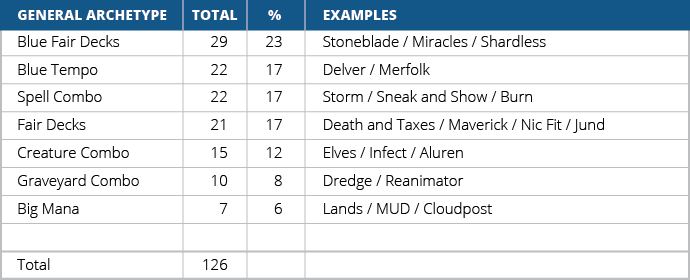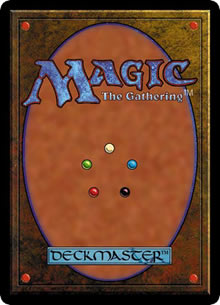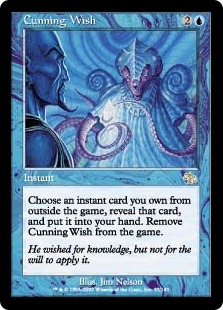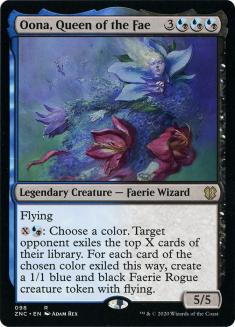In the wake of SCG Indianapolis, Legacy players might be even more confused as to where the format is heading. It seemed like the format would largely to
return to what it looked like pre-Treasure Cruise, but that doesn’t seem to be the case. Temur Delver and Miracles, where you at?
In a Top 8 full of combo decks, it’s no surprise to see the lone Delver of Secrets deck take down the tournament. Playing Storm seems dangerous if you
anticipate a field full of Delver decks, but it paid off for Caleb and Ben. Delver ended up being about 14% of the Day 2 field, which is a bit lower than
we’re used to. Perhaps weeks of playing with and against U/R Delver made people want to switch it up.
The official coverage has the Day 2 metagame breakdown here,
but I think it’s more efficient to look at it like this:

That’s a pretty nice mix of diversity, and surprisingly, not as blue-based as I would have thought. If you’re competing in a Legacy tournament, chances are
you have to be doing something proactive with a lot of general answers to various threats and strategies. That mentality is why I like Shardless Sultai so
much, but Jim Davis’ take on Sultai employs a similar take on things.
Creatures (16)
Lands (18)
Spells (26)

Daze, Spell Pierce, Force of Will, Thoughtseize, Wasteland, Abrupt Decay, and Dark Confidant are all cards that are great against a wide variety of decks.
It might surprise you that Sultai Delver had the most copies in Day 2 of any Delver deck, but it looks incredibly well-positioned in such a wide open
field.
I also appreciate Jim’s usage of Flooded Strand and Scalding Tarn in his Sultai deck.
A simpler way to look at the metagame breakdown might be this:

Overall, that looks pretty healthy! With Cruise gone and Dig Through Time still around, I wouldn’t have anticipated the Day 2 metagame to be nearly evenly
split. Obviously with Treasure Cruise in the format, you’re incentivized to play blue decks, but the same doesn’t appear to be true for Dig Through Time. I
think the issue is that we were all busy working on Treasure Cruises, but haven’t done the same for Dig Through Time.
So what are we supposed to do with Dig Through Time?
To start, I think it’s important to look at the Treasure Cruise era and see what we learned. It’s safe to say that towards the end of that era, the control
decks with Treasure Cruise were better than the aggro decks with Treasure Cruise. Sure, you could commit to an early Delver of Secrets or Monastery
Swiftspear and beat them down, but using that resource as a clock was often better served as a Thought Scour or counterspell.
You didn’t have to try and kill your opponents early because your clock was still relatively fast, and your best aggro draws with Delver could be raced
anyway. Instead, including the Thought Scour / Snapcaster Mage engine gave you more shots at hitting Treasure Cruise and more removal against the Delver
decks. Additionally, you’d save some maindeck slots that could be used for an extra piece of countermagic or two.
Creatures (9)
Lands (18)
Spells (33)
- 4 Brainstorm
- 4 Lightning Bolt
- 1 Counterspell
- 4 Force of Will
- 2 Swords to Plowshares
- 2 Pyroblast
- 2 Mental Note
- 2 Spell Snare
- 1 Forked Bolt
- 3 Gitaxian Probe
- 4 Thought Scour
- 4 Treasure Cruise
Sideboard

With Treasure Cruise, your games were generally pretty easy. You’d have enough resources to make land drops, kill or counter their stuff that mattered, and
find a way to clock them. With Dig Through Time, you don’t get to have it all. Now you have to make a meaningful choice between picking up that fourth land
or extra cantrip, whereas with Treasure Cruise you’d probably have both.
In that sense, Dig Through Time reminds me more of Brainstorm than Ancestral Recall. If your deck had eight Brainstorms, your card selection would be
amazing, but eventually you’d lose to someone who had a way to beat the threats you presented or break through the answers you had. At some point, you need
to either be gaining card advantage from something, clocking them, or finding a way to win that they can’t stop.
In the Treasure Cruise era, not only were people not playing very much mana denial (because it was difficult to actually keep them choked on mana when they
were drawing a lot of cards), but when you did play against the rare Wasteland deck, it almost never mattered. The Treasure Cruise decks were so mana
efficient that a Wasteland would typically set the Wasteland player back more than the Treasure Cruise player! It’s similar to how Shardless Sultai rarely
wants to use their Wastelands against Temur Delver. Your mana is better spent doing something else.
Now that Wasteland is back in the format, you actually have to care about it if you’re a Dig Through Time deck. Ideally, you’d be using Dig Through Time to
find an answer and another Dig Through Time, but when they are aggressively attacking your mana, you often have to a “waste” a Dig Through Time on a land
and a Brainstorm to make sure you don’t end up mana-screwed.
With Treasure Cruise, you used to incidentally have all these extra lands lying around. Sometimes they’d help you power through Wastelands and Stifles, and
sometimes it would give you a lot of resources to put back with Brainstorm, but now you don’t have the wealth of extra resources you used to. You actually
have to play fair Magic.
Because of all that, it’s pretty clear that Dig isn’t a direct swap for Treasure Cruise. They’re different enough that you can’t just swap one for the
other and call it a day. If you tried that, you might think that Dig Through Time isn’t a good card because it’s not good in those decks, but it’s actually
the reverse. You just need to find Dig Through Time a good home, and I think we can do that.
This is the deck I’ve been working on:
Creatures (5)
Lands (19)
Spells (36)

I wasn’t able to attend SCG Indianapolis, but Chris Andersen played the deck I would have played, so he ended up being my proxy. He finished in 13th (which
is a win away from Top 8) and even recorded a deck tech, so
he did me proud.
I told Chris the bad matchups were Storm, Lands, Elves, and potentially Burn. He tried to fix those matchups, and it sort of worked. He went 2-1 against
Burn, 1-0 against Lands, 1-0 against Elves, and 1-2 against Storm. So, aside from the poor Storm matchup, the deck seems pretty good. Chris also lost to
Jeskai Delver, which will happen every once in a while. Delver seems like a good matchup, but Delver is quite good at stealing games.
With the Jeskai Control deck, sometimes I was hard-pressed to stick my win condition. That led me to trying True-Name Nemesis, but it didn’t always get the
job done. The Thopter Foundry / Sword of the Meek combo was something I always wanted to make happen in Legacy, and this felt like the perfect opportunity.
Against most opponents, they have few, if any, ways to interact with the combo, especially considering the life buffer it gives you.
Dig Through Time does have an advantage over Treasure Cruise, and that it increases the value of having a situational one-of in your deck. In this case, it
also helped piece together the missing piece of the Thopter combo. Thought Scour and Mental Note fill your graveyard so much that casting Dig Through Time
for UU is par for the course, and occasionally the engine dumps a Sword of the Meek in your graveyard to be re-bought later.
In order to make the Sword of the Meek in the graveyard useful, I needed some artifacts that I could sacrifice to Thopter Foundry to start the combo. Seat
of the Synod was an easy one-of inclusion, as was a Sensei’s Divining Top. Past that, I didn’t really like any of the options, but that’s basically because
I was sticking to Jeskai.
Jeskai didn’t offer me much outside of Lightning Bolt, Pyroblast, and Wear, but I didn’t see much merit in what the other colors had to offer me. Then
Chris suggested Esper with Baleful Strix instead of the Lightning Bolts, and I was sold. Not only is Baleful Strix a hard removal spell for everything in
Temur Delver, but it’s an artifact! It’s also blue and draws a card. The only real downside is costing two mana, but that’s a helluva deal.
Supreme Verdict is a great maindeck one-of, as the longer the game goes, the chances of finding it increase dramatically. Sometimes you’re looking at as
many as twenty cards per turn, and that will typically find you what you need. That’s one of the reasons why it’s much better to play to a sort of combo
finish in Dig Through Time decks rather than just grabbing a couple Swords to Plowshares with it. Given enough time, you will find what you want, and in
the lategame, it might as well be something that locks up the game for you instead of prolonging it even further.
The Enlightened Tutor sideboard package is something I’ve never been super happy with, but it seemed to do well for Chris. In order for it to be worth the
sideboard space and the loss of a card when you actually cast the Tutor, the bullet needs to have a dramatic impact on the game. A card like Ethersworn
Canonist or Tsabo’s Web is going to put a severe cramp in your opponent’s gam plan, but Tutoring for something like a Detention Sphere or Baleful Strix
generally isn’t worth the card. Granted, Chris has both in his list, but that’s mostly because they are fine cards on their own. Tutoring for those cards
shouldn’t be part of your gameplan.
It might be possible to replicate the success I had with the Jeskai Control deck, except with the addition of Monastery Mentor. While your win condition is
still flimsy, I think the redundancy would help, as you’d be able to play a threat and make some creatures with it before it dies with relative
consistency.
Creatures (9)
Lands (18)
Spells (33)
- 4 Brainstorm
- 4 Lightning Bolt
- 4 Force of Will
- 4 Swords to Plowshares
- 2 Spell Snare
- 3 Spell Pierce
- 4 Gitaxian Probe
- 4 Thought Scour
- 4 Dig Through Time
Sideboard

I’ve seen people play and post similar decklists, but I like this one. This list is rather simplistic, but I think that’s where you want to be, since the
gameplan is simple.
You could certainly include basic lands if you wanted to, but I don’t see the need. It might make it easier to get to three lands in order to cast
Monastery Mentor, but I’d rather fight through Wastelands than not have all my lands tap for blue.
This might be another one of those decks that looks better on paper though. The Thopter Foundry win condition looks more consistent, if not outright
better. Of course, there’s still the option of trying to build a true combo-control deck, but I didn’t know what the win condition would be. Thankfully,
that’s what our resident Eternal expert Carsten Kotter is for.
Creatures (6)
Lands (20)
Spells (34)

This deck is legitimately scary.
Combo-control is probably my favorite archetype, so I definitely took a liking to this one. There’s a certain finesse about controlling the game and
eventually killing your opponent at your leisure. If you told me I could play Upheaval / Psychatog in Legacy, I’d be all about it. I might even be willing
to settle for something that feels similar.
I have yet to try Carsten’s deck, but will definitely do so in the future.
My initial impressions are:
Add:
Remove:
I would also change the sideboard some and possibly turn all the basics into duals. I think we could afford to cut the Academy Ruins and Lightning Bolt in
the sideboard, possibly for Massacres. Firestorm, as mentioned in the comments section of Carsten’s article, might be a cool sideboard option as well.
Cards like Spell Snare and Counterspell might have a home here, but that would likely involve shaving on combo pieces. I’d like to get the combo portion of
the deck as compact as possible, but that definitely comes with its own risks. You often won’t hold control forever, so playing more combo pieces might be
better overall.
I’m looking forward to the coming weeks and seeing if this deck puts up any results. I’m also interested to see if people experiment more with Dig Through
Time. It’s a powerful card, but it doesn’t fit everywhere. The trick is find the best place to put it or to create an entirely new deck.






